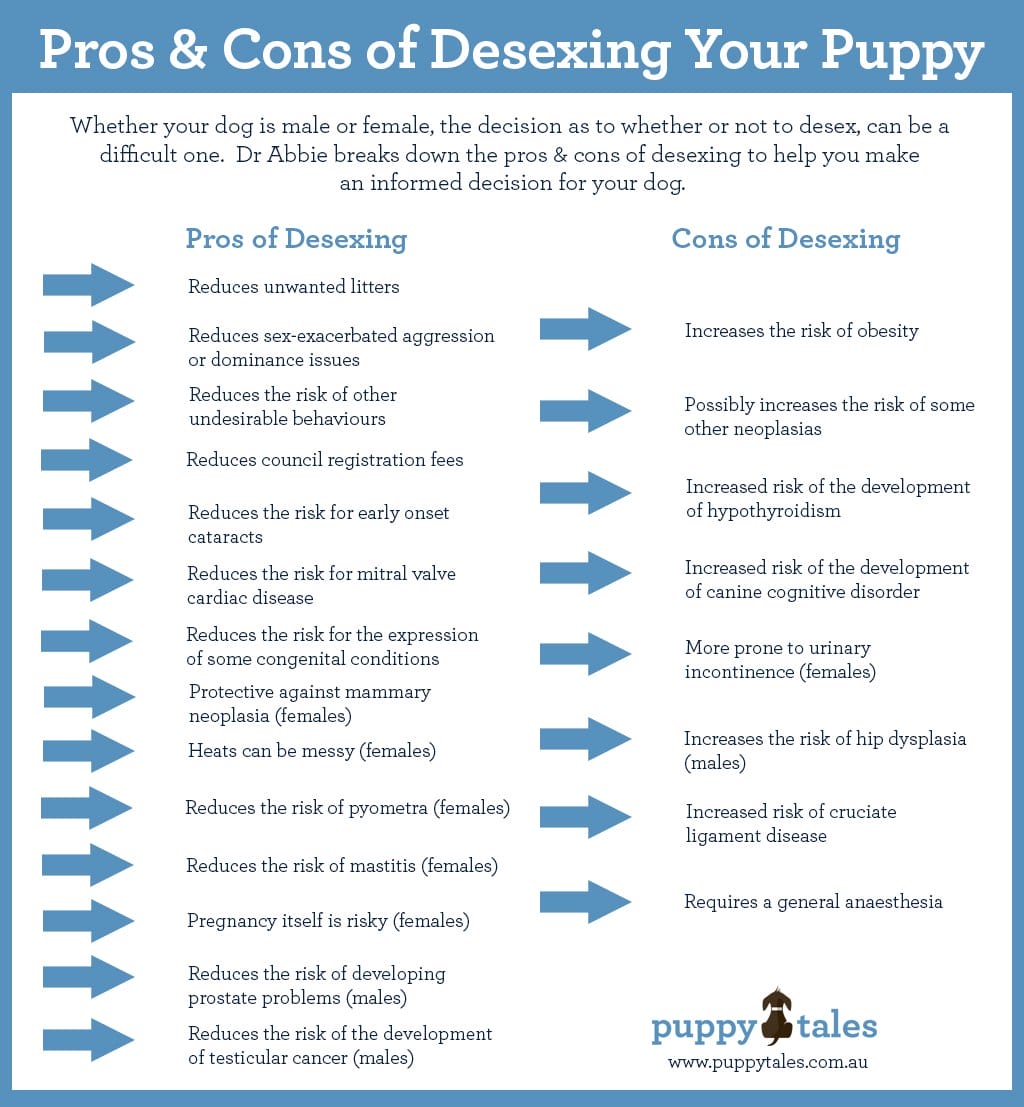Decisions around whether you should be desexing your dog and which age to desex can be complex. There is a lot of conflicting information on the internet, and there are even different procedures that can render your pet sterile. Confused? Don’t worry, this article is designed to help. It discusses the key pros and cons of desexing your dog and some considerations to take into account when making the decision that is right for your dog.

This post is authored by Dr Abbie Tipler ATCL BVSc, MANZCVS (Surgery), a surgical registrar at Veterinary Specialist Services. You can find her on Instagram here.
Before we continue, some useful definitions around Desexing Your Dog to know:
Neoplasia —> Cancer
Desexing —> Removing the ovaries +/- uterus in a female dog & testicles in a male dog to prevent reproduction
Intact/Entire —> A dog that has not been desexed
Spey —> Desexing a female dog
Castration —> Desexing a male dog
Pros to Desexing Your Dog
- There is the obvious and important reason of reducing unwanted litters. Thousands of healthy dogs are euthanased in Australia and around the world every year. The number of homes available is finite, and there is a problem with over-supply of puppies.
- The pros of desexing in regards to behaviour are that it reduces roaming and hormonally-driven inter-dog aggression. Entire dogs were more likely to be referred for aggression and reactivity than desexed dogs in one study and the most serious bite wound injuries involve entire dogs.
- Desexing reduces council registration fees.
- For female dogs, desexing has been shown to be protective against mammary neoplasia (cancer). Mammary neoplasia composes of around 50%-70% of total canine neoplasia in some populations. Female dogs that are desexed before their first heat (around 6 months of age) have a 0.05% risk of developing a mammary neoplasm later in life. Between the first and second heats the risk increases to 8%, and between the second and third heat, the risk is 26%. Intact female dogs aged 2 years and over, have 7 times greater risk of developing mammary neoplasia when compared to dogs desexed at around 6 months.
- In female dogs, heats can be messy. An entire female may bleed for several days, which can stain furniture/carpet etc. You may also see behaviour changes such as restlessness, humping/mounting behaviour, aggression, excessive vocalisation or difficulty controlling them around other dogs when in heat. These symptoms can be undesirable to the pet owner. It can also be very difficult to adequately confine a female dog on heat.
- Desexing in female dogs eliminates the risk of pyometra, which is an infection of the uterus. Approximately 25% of entire female dogs will develop a pyometra. Often the only treatment is emergency spey. Emergency ovariohysterectomies are not only a lot more expensive, but they have an increased risk of complications (as the patient is systemically compromised, versus a young healthy patient). Pyometra is potentially a fatal condition and treatment should be sought asap.
- Desexing in females dogs reduces the risk of metritis, mastitis, ovarian cysts, ovarian neoplasia, uterine neoplasia and vaginal neoplasia.
- Pregnancy itself in females can have complications. There can be complications such as problems delivering the puppies (sometimes also requiring emergency caesarian-section surgery), hypocalcemia, mastitis, hemorrhage and weight loss.
- In male dogs, desexing significantly reduces the risk of them developing prostate problems such as benign prostatic hyperplasia (enlarged prostate), prostatic cysts and prostatitis. It does not reduce the risk of prostate cancer
- In male dogs, desexing reduces the risk of perianal adenomas and perianal hernias.
- In male dogs, desexing eliminates the risk of testicular cancer. Testicular cancer has a good prognosis with castration, however.
- In one study, male and female dogs that were desexed had an overall increase in lifespan compared to entire dogs. There was an increased risk of death by cancer, but the increased risk of death by trauma and infectious disease outweighed this.
- In males and females, desexing reduces the risk of transmissible venereal tumors, which are sexually transmitted.
Cons to Desexing Your Dog
- Desexing increases the risk of neoplasia in some breeds. Examples include bone tumors, mast cell tumors and hemangiosarcoma. There is a very good article presenting some research out of UC Davis, looking at the prevalence of cancer, joint disorders and urinary incontinence by breed (35 dog breeds are investigated). Some breeds have an increased risk of neoplasia when desexed (not mixed breeds, see below article). One point of note about this article is that it does not take into account some of the advantages of desexing such as the reduced risk of trauma and infectious disease. There is a good summary on page 5 of the article, and it can be found by following this link. If you have a pure-breed dog and want specific information about how desexing may affect them, this is a good article to refer to.
- Desexing prior to skeletal maturity can increase the risk of orthopaedic diseases such as hip dysplasia, cruciate ligament disease and elbow dysplasia. For pure-breeds, refer to the article above for breed-related information. For mixed-breeds, the prevalence of orthopaedic disease is increased in dogs desexed prior to skeletal maturity (i.e. around 12-18 months. It is closer to 18 months for giant breeds) if 20kg or over (adult weight). This may be a reason to delay desexing until skeletal maturity in larger breeds of dogs. The following article looks at the prevalence of cancer, urinary incontinence and orthopaedic disease in mixed breeds.
- Female dogs that are desexed are more prone to urinary incontinence. This is the leaking of urine, usually when they are sleeping or relaxed, and it can respond well to medical therapy. This risk may be decreased by desexing after 12 months of age in larger dog breeds. This may be another reason to consider later desexing in the larger breeds. More information about the breed-specific risk of urinary incontinence can be found in the above two articles.
- Desexing increases the risk of obesity. It is extremely important to reduce calorie intake post desexing and ensure regular exercise. Obesity can lead to other obesity-related complications.
Personal Opinion and Summary
There are a few key things to consider when making decisions in regard to desexing your dog:
- Pyometra, unwanted pregnancies and mammary neoplasia are prevalent in populations of entire dogs. They can provide an unexpected and high expense to dog owners. Pyometra can occur as young as 9 months of age.
- Desexing your dog at skeletal maturity may decrease the risk of orthopaedic diseases in larger breeds over 20kg (adult body weight). In a dog expected to be 20kg or over, I would consider waiting until skeletal maturity before desexing.
- Some pure-breed dogs are more prone to cancers and this risk varies by breed. Again, you can refer to this article written in 2020 looking at 35 different breeds for more information on this.
The decision on age to desex your dog needs to take into account all of the pros and cons and specific breed and temperament factors.


Dr Abbie Tipler, BVSc, MACVS (Surgery)
Dr Abbie is a Small Animal Veterinarian with 10 years full-time experience. Her passion is Small Animal Surgery and in 2011 she studied towards and obtained her Memberships in Small Animal Surgery from the Australian College of Veterinary Scientists. Although surgery is her special interest, she loves all aspects of General Practice, especially canine medicine. She lives with her family and two Ragdoll cats.



